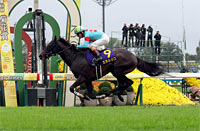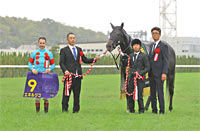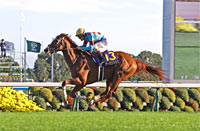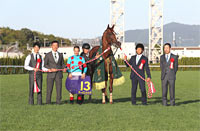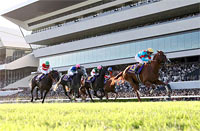Kikuka Sho (Japanese St. Leger) (G1) - Data Analysis
Final leg of the classic long-distance races contested on a 3,000m course
As the final leg of the Classic races, the Kikuka Sho (Japanese St. Leger) often turns into a clash between strong performers in the first two Classic races held in the spring season, and runners that have gained strength over the summer. Last year, Durezza pulled off a dramatic victory in his first graded race, finishing 3½ lengths ahead of 2023 Tokyo Yushun (Japanese Derby) winner Tastiera. So, which way will it go this year? Let’s now look for some trends in this race based on data for the last 10 years, including the years when the Kikuka Sho was held at Hanshin Racecourse.
Focus on runners that have finished in the Top 3 of their previous race
Many of the Top 3 finishers over the last 10 years had also finished in the Top 3 of their previous race. Only three runners that had finished 4th or lower last time out entered the Top 3, and these runners all had experience of finishing in the Top 4 of a G1 race. We should therefore sharply lower our expectations of runners that do not have a favorable record in G1 races and were beaten to 4th or lower in their previous race. [Table 1]
[Table 1] Performance by finish in previous race (last 10 years)
| Finish in previous race |
Performance
[1st-2nd-3rd-4th or lower] |
Win ratio |
Top 2 ratio |
Top 3 ratio |
| 3rd or higher |
9-9-9-75 |
8.8% |
17.6% |
26.5% |
| 4th or lower |
1-1-1-74 |
1.3% |
2.6% |
3.9% |
Runners coming from trial races enjoy success
Looking at performances by runners over the last 10 years in terms of their previous race, we find that runners that had previously contested the Kobe Shimbun Hai (Japanese St. Leger Trial) or the Asahi Hai St. Lite Kinen (Japanese St. Leger Trial) made up 21 of the 30 Top 3 finishers. Runners coming from a graded race other than a trial race only produced three Top 3 finishers. Among runners coming from an allowance-class race, Durezza triumphed last year. However, only six of the 50 runners in this group finished in the Top 3 over the last 10 years, making it difficult to recommend runners with such a record. In other words, when comparing the lead-up races of this year’s runners, we should focus on runners coming from trial races. [Table 2]
[Table 2] Performance by previous race (last 10 years)
| Previous race |
Performance
[1st-2nd-3rd-4th or lower] |
Win ratio |
Top 2 ratio |
Top 3 ratio |
Tokyo Yushun
(Japanese Derby) |
0-1-0-1 |
0% |
50.0% |
50.0% |
Kobe Shimbun Hai
(Japanese St. Leger Trial) |
5-4-4-52 |
7.7% |
13.8% |
20.0% |
Asahi Hai St. Lite Kinen
(Japanese St. Leger Trial) |
3-3-2-39 |
6.4% |
12.8% |
17.0% |
| Other graded race |
1-1-0-12 |
7.1% |
14.3% |
14.3% |
| Open-class race |
0-0-0-1 |
0% |
0% |
0% |
| 3-win class |
1-0-0-5 |
16.7% |
16.7% |
16.7% |
| 2-win class |
0-1-4-35 |
0% |
2.5% |
12.5% |
| 1-win class |
0-0-0-4 |
0% |
0% |
0% |
Focus on runners with 5 to 8 career starts
Among runners over the last 10 years, the majority of Top 3 finishers had between 5 and 8 career starts. Conversely, runners with 9 or more career starts had considerably lower success ratios. This suggests it is probably a good idea to focus on runners with 5 to 8 career starts. [Table 3]
[Table 3] Performance by total career starts (last 10 years)
| Total career starts |
Performance
[1st-2nd-3rd-4th or lower] |
Win ratio |
Top 2 ratio |
Top 3 ratio |
| 3 |
1-0-0-1 |
50.0% |
50.0% |
50.0% |
| 4 |
0-1-0-6 |
0% |
14.3% |
14.3% |
| 5 |
2-1-1-14 |
11.1% |
16.7% |
22.2% |
| 6 |
4-2-1-19 |
15.4% |
23.1% |
26.9% |
| 7 |
2-1-4-28 |
5.7% |
8.6% |
20.0% |
| 8 |
1-3-4-26 |
2.9% |
11.8% |
23.5% |
| 9 |
0-1-0-27 |
0% |
3.6% |
3.6% |
| 10 or more |
0-1-0-28 |
0% |
3.4% |
3.4% |
Christophe Lemaire has been the jockey to watch
It is often said that “jockeys determine the outcome of long-distance races,” and Christophe Lemaire has performed extremely well in the Kikuka Sho in recent years. He has achieved three victories in the race over the last 10 years, as well as—more recently—consecutive Top 2 finishes in the last three Kikuka Sho races he entered: 2nd riding Aristoteles in 2020, 2nd riding Orthoclase in 2021, and 1st riding Durezza in 2023. [Table 4]
[Table 4] Performance by major jockey (last 10 years)
| Jockey |
Performance
[1st-2nd-3rd-4th or lower] |
Win ratio |
Top 2 ratio |
Top 3 ratio |
| Christophe Lemaire |
3-2-1-2 |
37.5% |
62.5% |
75.0% |
| Mirco Demuro |
1-1-0-6 |
12.5% |
25.0% |
25.0% |
| Yutaka Take |
1-0-2-6 |
11.1% |
11.1% |
33.3% |
| Takeshi Yokoyama |
1-0-1-1 |
33.3% |
33.3% |
66.7% |
| Hironobu Tanabe |
1-0-0-7 |
12.5% |
12.5% |
12.5% |
| Hiroshi Kitamura |
1-0-0-3 |
25.0% |
25.0% |
25.0% |
| Manabu Sakai |
1-0-0-2 |
33.3% |
33.3% |
33.3% |
Note: Only active jockeys who have secured a victory in the Kikuka Sho are listed.
Seek out the winner!
Runners backed by high favoritism both in the Kikuka Sho and their previous race have the edge
The last eight winners had all been backed as 3rd favorite or higher in their previous race. In addition, seven of the eight runners were backed as 4th favorite or higher in the Kikuka Sho. When predicting the potential winner, we should also take into consideration this trend. [Table 5]
[Table 5] Winners’ favoritism and favoritism in previous race (last eight years)
| Year |
Winner |
Favoritism |
Favoritism in previous race |
| 2016 |
Satono Diamond |
1st favorite |
1st favorite |
| 2017 |
Kiseki |
1st favorite |
2nd favorite |
| 2018 |
Fierement |
7th favorite |
1st favorite |
| 2019 |
World Premiere |
3rd favorite |
3rd favorite |
| 2020 |
Contrail |
1st favorite |
1st favorite |
| 2021 |
Titleholder |
4th favorite |
1st favorite |
| 2022 |
Ask Victor More |
2nd favorite |
1st favorite |
| 2023 |
Durezza |
4th favorite |
1st favorite |
(Yodohito Himezono)
|















